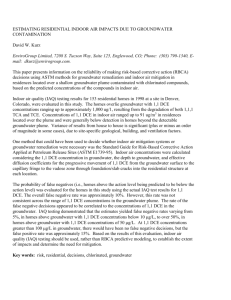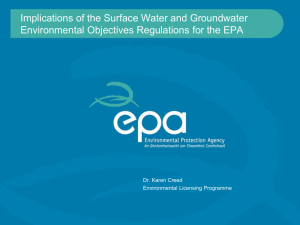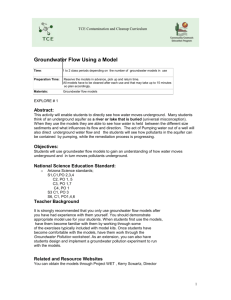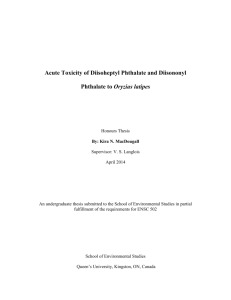15A NCAC 02L .0202 GROUNDWATER QUALITY STANDARDS (a
advertisement
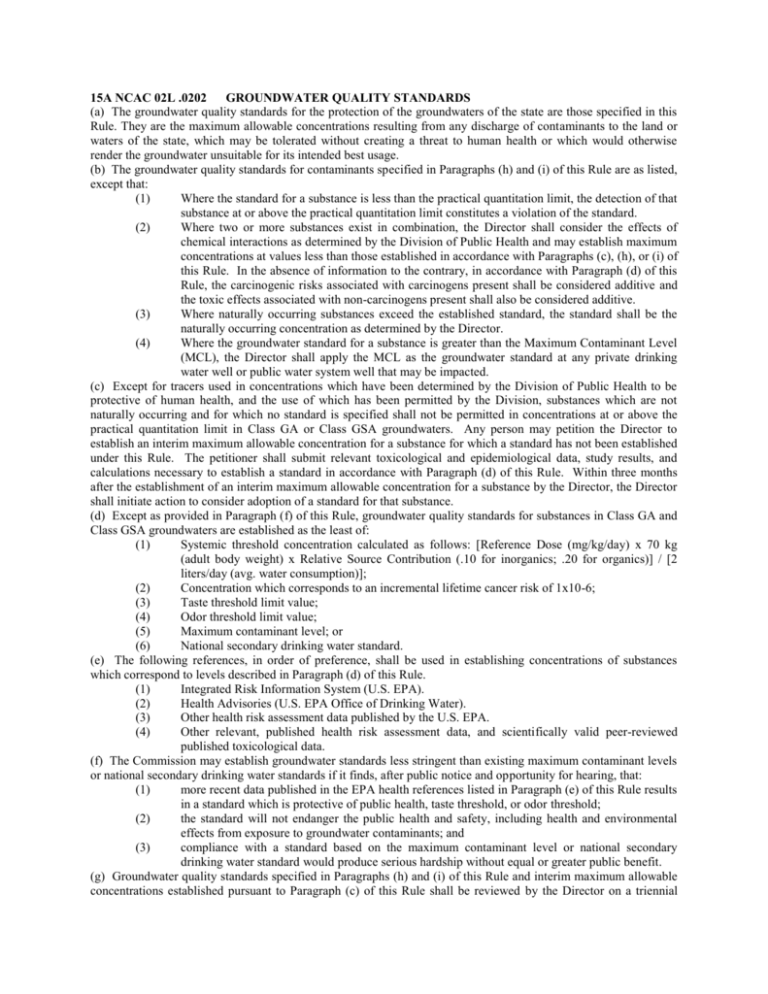
15A NCAC 02L .0202 GROUNDWATER QUALITY STANDARDS (a) The groundwater quality standards for the protection of the groundwaters of the state are those specified in this Rule. They are the maximum allowable concentrations resulting from any discharge of contaminants to the land or waters of the state, which may be tolerated without creating a threat to human health or which would otherwise render the groundwater unsuitable for its intended best usage. (b) The groundwater quality standards for contaminants specified in Paragraphs (h) and (i) of this Rule are as listed, except that: (1) Where the standard for a substance is less than the practical quantitation limit, the detection of that substance at or above the practical quantitation limit constitutes a violation of the standard. (2) Where two or more substances exist in combination, the Director shall consider the effects of chemical interactions as determined by the Division of Public Health and may establish maximum concentrations at values less than those established in accordance with Paragraphs (c), (h), or (i) of this Rule. In the absence of information to the contrary, in accordance with Paragraph (d) of this Rule, the carcinogenic risks associated with carcinogens present shall be considered additive and the toxic effects associated with non-carcinogens present shall also be considered additive. (3) Where naturally occurring substances exceed the established standard, the standard shall be the naturally occurring concentration as determined by the Director. (4) Where the groundwater standard for a substance is greater than the Maximum Contaminant Level (MCL), the Director shall apply the MCL as the groundwater standard at any private drinking water well or public water system well that may be impacted. (c) Except for tracers used in concentrations which have been determined by the Division of Public Health to be protective of human health, and the use of which has been permitted by the Division, substances which are not naturally occurring and for which no standard is specified shall not be permitted in concentrations at or above the practical quantitation limit in Class GA or Class GSA groundwaters. Any person may petition the Director to establish an interim maximum allowable concentration for a substance for which a standard has not been established under this Rule. The petitioner shall submit relevant toxicological and epidemiological data, study results, and calculations necessary to establish a standard in accordance with Paragraph (d) of this Rule. Within three months after the establishment of an interim maximum allowable concentration for a substance by the Director, the Director shall initiate action to consider adoption of a standard for that substance. (d) Except as provided in Paragraph (f) of this Rule, groundwater quality standards for substances in Class GA and Class GSA groundwaters are established as the least of: (1) Systemic threshold concentration calculated as follows: [Reference Dose (mg/kg/day) x 70 kg (adult body weight) x Relative Source Contribution (.10 for inorganics; .20 for organics)] / [2 liters/day (avg. water consumption)]; (2) Concentration which corresponds to an incremental lifetime cancer risk of 1x10-6; (3) Taste threshold limit value; (4) Odor threshold limit value; (5) Maximum contaminant level; or (6) National secondary drinking water standard. (e) The following references, in order of preference, shall be used in establishing concentrations of substances which correspond to levels described in Paragraph (d) of this Rule. (1) Integrated Risk Information System (U.S. EPA). (2) Health Advisories (U.S. EPA Office of Drinking Water). (3) Other health risk assessment data published by the U.S. EPA. (4) Other relevant, published health risk assessment data, and scientifically valid peer-reviewed published toxicological data. (f) The Commission may establish groundwater standards less stringent than existing maximum contaminant levels or national secondary drinking water standards if it finds, after public notice and opportunity for hearing, that: (1) more recent data published in the EPA health references listed in Paragraph (e) of this Rule results in a standard which is protective of public health, taste threshold, or odor threshold; (2) the standard will not endanger the public health and safety, including health and environmental effects from exposure to groundwater contaminants; and (3) compliance with a standard based on the maximum contaminant level or national secondary drinking water standard would produce serious hardship without equal or greater public benefit. (g) Groundwater quality standards specified in Paragraphs (h) and (i) of this Rule and interim maximum allowable concentrations established pursuant to Paragraph (c) of this Rule shall be reviewed by the Director on a triennial basis. Appropriate modifications to established standards shall be made in accordance with the procedure prescribed in Paragraph (d) of this Rule where modifications are considered appropriate based on data published subsequent to the previous review. (h) Class GA Standards. Unless otherwise indicated, the standard refers to the total concentration in micrograms per liter of any constituent in a dissolved, colloidal or particulate form which is mobile in groundwater. This does not apply to sediment or other particulate matter which is preserved in a groundwater sample as a result of well construction or sampling procedures. The Class GA standards are: (1) Acenaphthene: 80; (2) Acenaphthylene: 200; (3) Acetone: 6 mg/L; (4) Acrylamide: 0.008; (5) Anthracene: 2 mg/L; (6) Arsenic: 10; (7) Atrazine and chlorotriazine metabolites: 3; (8) Barium: 700; (9) Benzene: 1; (10) Benzo(a)anthracene (benz(a)anthracene): 0.05; (11) Benzo(b)fluoranthene: 0.05; (12) Benzo(k)fluoranthene: 0.5; (13) Benzoic acid: 30 mg/L; (14) Benzo(g,h,i,)perylene: 200; (15) Benzo(a)pyrene: 0.005; (16) Bis(chloroethyl)ether: 0.03; (17) Bis(2-ethylhexyl) phthalate (di(2-ethylhexyl) phthalate): 3; (18) Boron: 700; (19) Bromodichloromethane: 0.6; (20) Bromoform (tribromomethane): 4; (21) n-Butylbenzene: 70; (22) sec-Butylbenzene: 70; (23) tert-Butylbenzene: 70; (24) Butylbenzyl phthalate: 1 mg/L; (25) Cadmium: 2; (26) Caprolactam: 4 mg/L; (27) Carbofuran: 40; (28) Carbon disulfide: 700; (29) Carbon tetrachloride: 0.3; (30) Chlordane: 0.1; (31) Chloride: 250 mg/L; (32) Chlorobenzene: 50; (33) Chloroethane: 3,000; (34) Chloroform (trichloromethane): 70; (35) Chloromethane (methyl chloride): 3; (36) 2-Chlorophenol: 0.4; (37) 2-Chlorotoluene (o-chlorotoluene): 100; (38) Chromium: 10; (39) Chrysene: 5; (40) Coliform organisms (total): 1 per 100 mL; (41) Color: 15 color units; (42) Copper: 1 mg/L; (43) Cyanide (free cyanide): 70; (44) 2, 4-D (2,4-dichlorophenoxy acetic acid): 70; (45) DDD: 0.1; (46) DDT: 0.1; (47) Dibenz(a,h)anthracene: 0.005; (48) Dibromochloromethane: 0.4; (49) 1,2-Dibromo-3-chloropropane: 0.04; (50) (51) (52) (53) (54) (55) (56) (57) (58) (59) (60) (61) (62) (63) (64) (65) (66) (67) (68) (69) (70) (71) (72) (73) (74) (75) (76) (77) (78) (79) (80) (81) (82) (83) (84) (85) (86) (87) (88) (89) (90) (91) (92) (93) (94) (95) (96) (97) (98) (99) (100) (101) (102) (103) (104) (105) Dibutyl (or di-n-butyl) phthalate: 700; 1,2-Dichlorobenzene (orthodichlorobenzene): 20; 1,3-Dichlorobenzene (metadichlorobenzene): 200; 1,4-Dichlorobenzene (paradichlorobenzene): 6; Dichlorodifluoromethane (Freon-12; Halon): 1 mg/L; 1,1-Dichloroethane: 6; 1,2-Dichloroethane (ethylene dichloride): 0.4; 1,2-Dichloroethene (cis): 70; 1,2-Dichloroethene (trans): 100; 1,1-Dichloroethylene (vinylidene chloride): 350; 1,2-Dichloropropane: 0.6; 1,3-Dichloropropene (cis and trans isomers): 0.4; Dieldrin: 0.002; Diethylphthalate: 6 mg/L; 2,4-Dimethylphenol (m-xylenol): 100; Di-n-octyl phthalate: 100; 1,4-Dioxane (p-dioxane): 3; Dioxin (2,3,7,8-TCDD): 0.0002 ng/L; 1,1– Diphenyl (1,1,-biphenyl): 400; Dissolved solids (total): 500 mg/L; Disulfoton: 0.3; Diundecyl phthalate (Santicizer 711): 100; Endosulfan: 40; Endrin, total (includes endrin, endrin aldehyde and endrin ketone): 2; Epichlorohydrin: 4; Ethyl acetate: 3 mg/L; Ethylbenzene: 600; Ethylene dibromide (1,2-dibromoethane): 0.02; Ethylene glycol: 10 mg/L; Fluoranthene: 300; Fluorene: 300; Fluoride: 2 mg/L; Foaming agents: 500; Formaldehyde: 600; Gross alpha (adjusted) particle activity (excluding radium-226 and uranium): 15 pCi/L; Heptachlor: 0.008; Heptachlor epoxide: 0.004; Heptane: 400; Hexachlorobenzene (perchlorobenzene): 0.02; Hexachlorobutadiene: 0.4; Hexachlorocyclohexane isomers (technical grade): 0.02; n-Hexane: 400; Indeno(1,2,3-cd)pyrene: 0.05; Iron: 300; Isophorone: 40; Isopropylbenzene: 70; Isopropyl ether: 70; Lead: 15; Lindane (gamma hexachlorocyclohexane): 0.03; Manganese: 50; Mercury: 1; Methanol: 4 mg/L; Methoxychlor: 40; Methylene chloride (dichloromethane): 5; Methyl ethyl ketone (2-butanone): 4 mg/L; 2-Methylnaphthalene: 30; (106) 3-Methylphenol (m-cresol): 400; (107) 4-Methylphenol (p-cresol): 40; (108) Methyl tert-butyl ether (MTBE): 20; (109) Naphthalene: 6; (110) Nickel: 100; (111) Nitrate (as N): 10 mg/L; (112) Nitrite (as N): 1 mg/L; (113) N-nitrosodimethylamine: 0.0007; (114) Oxamyl: 200; (115) Pentachlorophenol: 0.3; (116) Petroleum aliphatic carbon fraction class (C5 - C8): 400; (117) Petroleum aliphatic carbon fraction class (C9 - C18): 700; (118) Petroleum aliphatic carbon fraction class (C19 - C36): 10 mg/L; (119) Petroleum aromatics carbon fraction class (C9 - C22): 200; (120) pH: 6.5 - 8.5; (121) Phenanthrene: 200; (122) Phenol: 30; (123) Phorate: 1; (124) n-Propylbenzene: 70; (125) Pyrene: 200; (126) Selenium: 20; (127) Silver: 20; (128) Simazine: 4; (129) Styrene: 70; (130) Sulfate: 250 mg/L; (131) 1,1,2,2-Tetrachloroethane: 0.2; (132) Tetrachloroethylene (perchloroethylene; PCE): 0.7; (133) 2,3,4,6-Tetrachlorophenol: 200; (134) Toluene: 600; (135) Toxaphene: 0.03; (136) 2,4,5-TP (Silvex): 50; (137) 1,2,4-Trichlorobenzene: 70; (138) 1,1,1-Trichloroethane: 200; (139) Trichloroethylene (TCE): 3; (140) Trichlorofluoromethane: 2 mg/L; (141) 1,2,3-Trichloropropane: 0.005; (142) 1,2,4-Trimethylbenzene: 400; (143) 1,3,5-Trimethylbenzene: 400; (144) 1,1,2-Trichloro-1,2,2-trifluoroethane (CFC-113): 200 mg/L; (145) Vinyl chloride: 0.03; (146) Xylenes (o-, m-, and p-): 500; and (147) Zinc: 1 mg/L. (i) Class GSA Standards. The standards for this class are the same as those for Class GA except as follows: (1) chloride: allowable increase not to exceed 100 percent of the natural quality concentration; and (2) dissolved solids (total): 1000 mg/L. (j) Class GC Standards. (1) The concentrations of substances that, at the time of classification, exceed the standards applicable to Class GA or GSA groundwaters shall not be caused to increase, nor shall the concentrations of other substances be caused to exceed the GA or GSA standards as a result of further disposal of contaminants to or beneath the surface of the land within the boundary of the area classified GC. (2) The concentrations of substances that, at the time of classification, exceed the standards applicable to GA or GSA groundwaters shall not be caused to migrate as a result of activities within the boundary of the GC classification, so as to violate the groundwater or surface water quality standards in adjoining waters of a different class. (3) Concentrations of specific substances, that exceed the established standard at the time of classification, are listed in Section .0300 of this Subchapter. History Note: Authority G.S. 143-214.1; 143B-282(a)(2); Eff. June 10, 1979; Amended Eff. November 1, 1994; October 1, 1993; September 1, 1992; August 1, 1989; Temporary Amendment Eff. June 30, 2002; Amended Eff. August 1, 2002; Temporary Amendment Expired February 9, 2003; Amended Eff. April 1, 2013; January 1, 2010; April 1, 2005.




